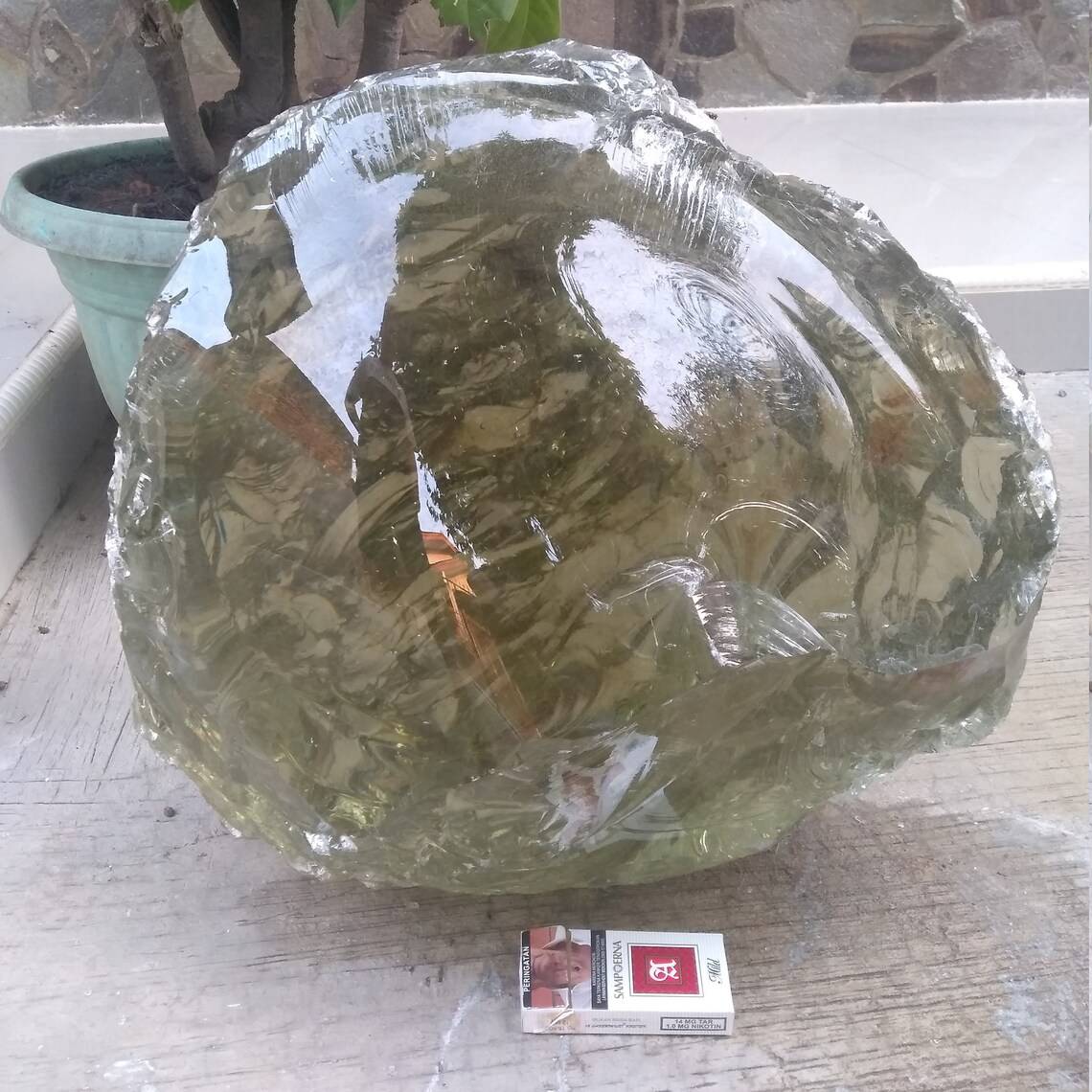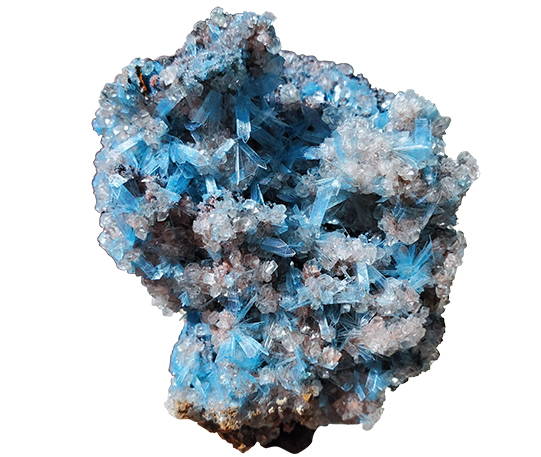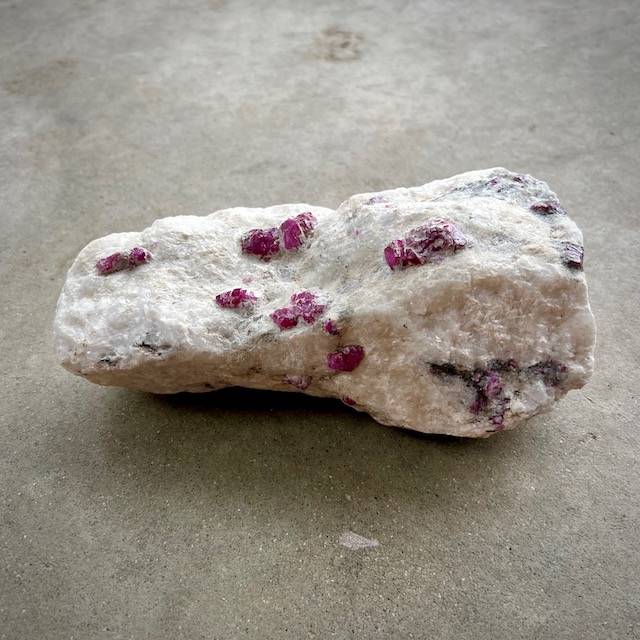“FOOL’S GLASS”
& MORE MINERAL FAKERY
In Chapter 6 of my book, The Crystal Workshop: A Journey into the Healing Power of Crystals, I go into detail about the most common ways crystals are faked and altered. In this newsletter I’m going to share a couple more examples of fake minerals so that you may further educate yourself about the kinds of deceptions sadly prevalent in the commerce of minerals.
Hopefully you are already aware of some of the more common artificial treatments, like crispy citrine and aura quartz that infiltrate the crystal healing market. (Again, see Chapter 6 in my book to learn more.) But lately, I’ve been noticing the growing rise of so-called Andara “crystals” gaining prominence online and on social media.
There are some ridiculous stories associated with “Andara crystals,” like how they “...come from a very sacred place in Hawaii”, and then are “buried in a sacred land for 9 years”. And then there are the banal andtrite crystal descriptions that are associated with it, like this one self-purported “master crystal healer” describing the properties of the stone as being able to “clear negativity, activates, and aligns all the chakras and rapidly accelerates spiritual growth”. (In my book I have cautioned readers to be skeptical of overly generalized metaphysical descriptions like these, but Iwould also encourage them to extend their skepticism to those who claim grand connections with crystals yet still speak of them in such a clichéd way.) What’s shocking is how popular these purported ‘’crystals” have become. They don’t look like natural minerals at all. And that’s probably because they are lumps of factory made glass!
A byproduct of steel production, slag glass is created when iron ore is smelted and the glass residue is melted out. This man-made glass will take on different colors depending on the trace minerals that remain in the slag. My suspicion is that the sale of Andara crystals began when someone who happened to have some glass slag wanted to sell it off. Knowing that the market for metaphysical crystals was quite lucrative, they made up some spiritual properties of the stone and started selling it. As the rumors spread and its popularity started taking off, other people probably started melting down glass, added colorants in more metaphysically trendy colors, and started selling it at fantastically outrageous prices to the metaphysical market.

Using Angel numbers and an exorbitant price to dupe people to buy a piece of glass.

An “Andara” being sold online for almost $11k.
I’m not sure the addition of a cigarette box for scale adds to its spirituality.
There is a natural glass made by Mother Earth, called obsidian. While glass has the same basic chemical formula and structure as obsidian (SiO2), the big difference between obsidian and glass like Andara is that obsidian is wholly a creation of Mother Earth. From deep within herself, Mother Earth extrudes hot lava out of her volcanoes, and when this lava rapidly cools in the air, it turns into obsidian. This process infuses the stone with a matrix of her healing energies. That means glass man-made in factories with god knows whose energies overseeing the process is not a recipe for healing energy, nor receiving Mother Earth’s healing touch.
Yet as the crystal craze continues, Andara crystals are being sold for outrageous prices and people are getting stupidly rich for selling them.
... But it’s not only the crystal healing market that is being duped in the mineral world. While metaphysical crystal buyers are the easiest targets (since all they seem to need is some purported metaphysical properties) mineral fakery is also prevalent in the more scientific side of mineral collecting.
You may find that some of the crystals I carry are pricey, but they are nowhere close to all the commas and zeros you’ll see at the end of many price tags sold by mineral dealers. It’s actually quite common for crystals to sell for thousands, tens of thousands, even in the over hundred thousand dollar range. Lots of big money gets exchanged at the gem and mineral shows for collectors seeking pristine examples of crystals, with rare rminerals or more naturally sculptural presentations demanding even higher prices.
The dealers who sell these kinds of crystals are into the scientific side of mineralogy. Authenticity in a mineral’s natural origins is paramount-- selling fake crystals would be ruinous to a dealer’s reputation and standing in the mineral community. When alteration and fakery is suspected in the mineral community, gossip will spread within the mineral nerds (a term I usewith 100% affection) who will apply their scientific knowledge and skills to determine if deceit is involved in a crystal specimen. Some people are such experts that they can determine many of the fakeries by sight because of their encyclopedic knowledge of minerology. Other suspected specimens will go through more rigorous scientific testing before their deception can be determined, but not before duping some very well-informed people, like this next story I will tell you...
...New crystals are discovered all the time. The grand majority of them are minerals we know about, but in layman’s terms a mineral can have varieties of different shapes, formations, and colors because of the slight variances in chemicals in the ground along with nuances in temperature and pressure affecting crystal growth. This is one reason why quartz can come in so many different colors and shapes. Each year, new versions of minerals are discovered and brought out to the market.
In recent years, a supposedly new color variant of hemimorphite came out of a mine in Mexico. Though clear hemimorphite had been found in this mine previously, this time the specimens that were being found were a dazzling blue. Mineral collectors get very excited about new finds like these and this blue hemimorphite was no exception. Collectors excitingly began buying up the crystals.
But there were some people in the mineral community that were not convinced of the crystal’s authenticity, like a good friend of mine-- a well-respected and high-profile member of the minerology world whom other scientists and collectors came to for his expertise. The highly saturated and even color was suspicious to many. It was normally indicative that the specimen had been dyed, but these specimens didn’t have the other tell-tale clues of that being the case.
For one, when most minerals are dyed, it’s through a deposition method that involves impregnating pigment into the microscopic voids of a crystal (like the styrofoam peanuts fillingvoids in a boxed package-- the styrofoam being the dye). Dyes like this will leech color when submerged in common solvents like water or acetone, but when these hemimorphites were tested with solvents, they did not leech any color. Secondly, and a big reason why many collectors felt that these crystals were real, was that the hemimorphite specimens also contained clear colored calcite. Normally, when crystals are dyed, the whole mineral becomes tinged with the dye, but the calcites were completely unaffected. This was ultimate proof, they argued to my expert mineral friend, that the crystals had not been dyed and were the real deal-- but my friend was not so sure.
My mineralogist friend thought about how the mine had never ever produced blue specimens before. Usually, you expect to see a gradation of color to come out of a mine. Miners find a vein and as they dig out the mineral, another color may begin appearing. But it’s always a gradation of a color, never from clear then to a suddenly intense color like these blue Mexican hemimorphites. Yet many felt there was enough evidence pointing to them being real and bought big. One prominent dealer with an esteemed reputation bought $100k of these crystals to resell.
The suspicious hemimorphite specimens finally landed in the purview of a mineralogist who also happened to have sophisticated knowledge of dye chemistry. He quickly determined that the hemimorphite had been dyed, but in a very novel and clever way.
As I described earlier, the dye fakery that had been previously seen in the mineral world had been a result of the deposition dyeing, something scientists and collectors were well aware of. However in thecase of these hemimorphites, the color had been chemically bonded-- that is permanently bonded to the surface of the crystal. This is why putting the specimens in solvent didn’t leech color. (Chemical bonding is the same method that is used in most modern clothing dyes. That’s why most of your clothing goes through the wash and doesn’t bleed color-- because the dye has been chemically and permanently bonded to the fiber. Versus back in the day when you had to separate out your red clothing to wash because it so easily bled. That’s because the red dyes used back then only coated the fibers and would shed their color when put in a solvent like water.) The chemistry of hemimorphite includes a hydroxol group, which can permanently bond with certain chemicals they come in contact with. The dye smart mineralogist saw that the surface of the hemimorphites had been bonded with a chemical to produce its saturated blue color. The chemical solution used?: Ordinary household blue-colored toilet bowl cleaner.

A dyed hemimorphite with calcite crystals unaffected. (EvanJones)
This incident caused a whole ruckus in the mineral world,with many people very upset about the results-- nobody likes to be hoodwinked. Whenmy minerologist friend told me that people were urging the duped dealer to go to Mexico and get his money back, I shook my head in alarm. This would be definitely a bad idea, I replied, because anyone that sophisticated about chemistry in rural Mexico was most likely working for the cartels, to which my worldly minerologist friend nodded in knowing agreement. The fact the this chemist had figured out a chemical dye process that duped sophisticated dealers and collectors was someone very smart, someone who probably knew about the mineral collecting world, and was aware there could be quick money to be made. Because beyond their main business of drugs, cartels are involved in avocados, oil, fishing, animal trafficking, logging-- basically any other industry they can infiltrate and make profit in. And considering the amount of money that is in mineral collecting, it would be no surprise that they were also involved with crystals!
Morals of the story:

This fake specimen was sold for an embarrassing amount of money to a high-end mineral collector who paid the price of an authentic piece. Looking closely, the ruby pieces are real but have clearly been glued on. The vendor who I got it from said it was worthless but would make a good doorstop.
